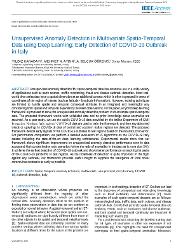| dc.contributor.author | Karadayı, Yıldız | |
| dc.contributor.author | Aydın, Mehmet Nafiz | |
| dc.contributor.author | Öğrenci, Arif Selçuk | |
| dc.date.accessioned | 2020-12-11T18:07:10Z | |
| dc.date.available | 2020-12-11T18:07:10Z | |
| dc.date.issued | 2020 | |
| dc.identifier.issn | 2169-3536 | en_US |
| dc.identifier.uri | https://hdl.handle.net/20.500.12469/3514 | |
| dc.identifier.uri | https://doi.org/10.1109/ACCESS.2020.3022366 | |
| dc.description.abstract | Unsupervised anomaly detection for spatio-temporal data has extensive use in a wide variety of applications such as earth science, traffic monitoring, fraud and disease outbreak detection. Most real-world time series data have a spatial dimension as an additional context which is often expressed in terms of coordinates of the region of interest (such as latitude - longitude information). However, existing techniques are limited to handle spatial and temporal contextual attributes in an integrated and meaningful way considering both spatial and temporal dependency between observations. In this paper, a hybrid deep learning framework is proposed to solve the unsupervised anomaly detection problem in multivariate spatio-temporal data. The proposed framework works with unlabeled data and no prior knowledge about anomalies are assumed. As a case study, we use the public COVID-19 data provided by the Italian Department of Civil Protection. Northern Italy regions' COVID-19 data are used to train the framework; and then any abnormal trends or upswings in COVID-19 data of central and southern Italian regions are detected. The proposed framework detects early signals of the COVID-19 outbreak in test regions based on the reconstruction error. For performance comparison, we perform a detailed evaluation of 15 algorithms on the COVID-19 Italy dataset including the state-of-the-art deep learning architectures. Experimental results show that our framework shows significant improvement on unsupervised anomaly detection performance even in data scarce and high contamination ratio scenarios (where the ratio of anomalies in the data set is more than 5%). It achieves the earliest detection of COVID-19 outbreak and shows better performance on tracking the peaks of the COVID-19 pandemic in test regions. As the timeliness of detection is quite important in the fight against any outbreak, our framework provides useful insight to suppress the resurgence of local novel coronavirus outbreaks as early as possible. | en_US |
| dc.description.sponsorship | Kadir Has University | en_US |
| dc.language.iso | eng | en_US |
| dc.publisher | Ieee-Inst Electrıcal Electronıcs Engıneers Inc | en_US |
| dc.rights | info:eu-repo/semantics/openAccess | en_US |
| dc.subject | Anomaly detection | en_US |
| dc.subject | Machine learning | en_US |
| dc.subject | Spatial databases | en_US |
| dc.subject | Clustering algorithms | en_US |
| dc.subject | Diseases | en_US |
| dc.subject | Time series analysis | en_US |
| dc.subject | Data models | en_US |
| dc.subject | Spatio-temporal anomaly detection | en_US |
| dc.subject | Deep learning | en_US |
| dc.subject | COVID-19 | en_US |
| dc.subject | Outbreak detection | en_US |
| dc.subject | Italy | en_US |
| dc.subject | Multivariate data | en_US |
| dc.subject | Unsupervised | en_US |
| dc.title | Unsupervised Anomaly Detection in Multivariate Spatio-Temporal Data Using Deep Learning: Early Detection of COVID-19 Outbreak in Italy | en_US |
| dc.type | article | en_US |
| dc.identifier.startpage | 164155 | en_US |
| dc.identifier.endpage | 164177 | en_US |
| dc.relation.journal | Ieee Access | en_US |
| dc.identifier.volume | 8 | en_US |
| dc.department | Fakülteler, İşletme Fakültesi, Yönetim Bilişim Sistemleri Bölümü | en_US |
| dc.department | Fakülteler, Mühendislik ve Doğa Bilimleri Fakültesi, Bilgisayar Mühendisliği Bölümü | en_US |
| dc.department | Fakülteler, Mühendislik ve Doğa Bilimleri Fakültesi, Elektrik-Elektronik Mühendisliği Bölümü | en_US |
| dc.identifier.wos | WOS:000573031400001 | en_US |
| dc.identifier.doi | 10.1109/ACCESS.2020.3022366 | en_US |
| dc.identifier.scopus | 2-s2.0-85096693273 | en_US |
| dc.institutionauthor | Karadayı, Yıldız | en_US |
| dc.institutionauthor | Aydın, Mehmet Nafiz | en_US |
| dc.institutionauthor | Öǧrenci, Arif Selçuk | en_US |
| dc.relation.publicationcategory | Makale - Uluslararası Hakemli Dergi - Kurum Öğretim Elemanı | en_US |
| dc.identifier.pmid | 34931155 | en_US |
















